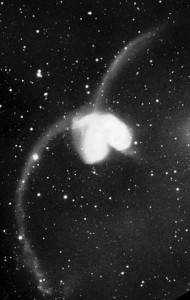The Antennae Galaxies are probably the most famous and beautiful example of a cosmic traffic accident in the sky: two spiral galaxies undergoing a massive collision. Davide De Martin took the Hubble images of this pair and reprocessed them as part of his Sky Factory project:
Holy wow! These galaxies are very roughly 45 million light years away, which is relatively close. That means images from Hubble yield vast details. For example, the reddish-pink star-forming bursts, triggered by the collisions of huge dust and gas clouds, are obvious. Long streamers of visible-light-blocking dust can be seen, as well as many individual, massive and bright stars. The overall yellowish glow is from the collected light of tens of billions of stars like the Sun; too faint to be seen on their own, but adding up to provide the background for the more dynamic and dramatic goings-on.
 The Hubble image only shows the cores of the colliding pair, but wider and deeper images, like this one shown on the right, show why they’re called the Antennae: the gravity of the interacting pair has drawn out two long streamers of stars and gas, called tidal tails. This is commonly seen when two galaxies collide.
The Hubble image only shows the cores of the colliding pair, but wider and deeper images, like this one shown on the right, show why they’re called the Antennae: the gravity of the interacting pair has drawn out two long streamers of stars and gas, called tidal tails. This is commonly seen when two galaxies collide.
The two galaxies have already passed through each other, the major event happening hundreds of millions of years ago. Eventually, over the next few hundred million years, these two galaxies will merge to form one more massive elliptical galaxy. The cores will eventually consolidate, and the supermassive black holes that lie there unseen in their cores will also merge, making a slightly bigger black hole.
And if you think this sounds like some fantastic science fiction scenario, bear in mind that this same fate almost certainly awaits us: we’ll collide with the Andromeda Galaxy in a billion years or two. When we do, we’ll look a lot like this! So take a good look now. Your great-great-greatnth descendants may not need a Hubble to be able to watch something like this; they’ll just go out their front door and look up.
Image credits: Davide de Martin, NASA.
Related posts:
- Snapshot of galactic doom
- The beauty of cosmic collisions
- Hubble catches a jet collision
- Binary black hole terrorizes quasar nucleus